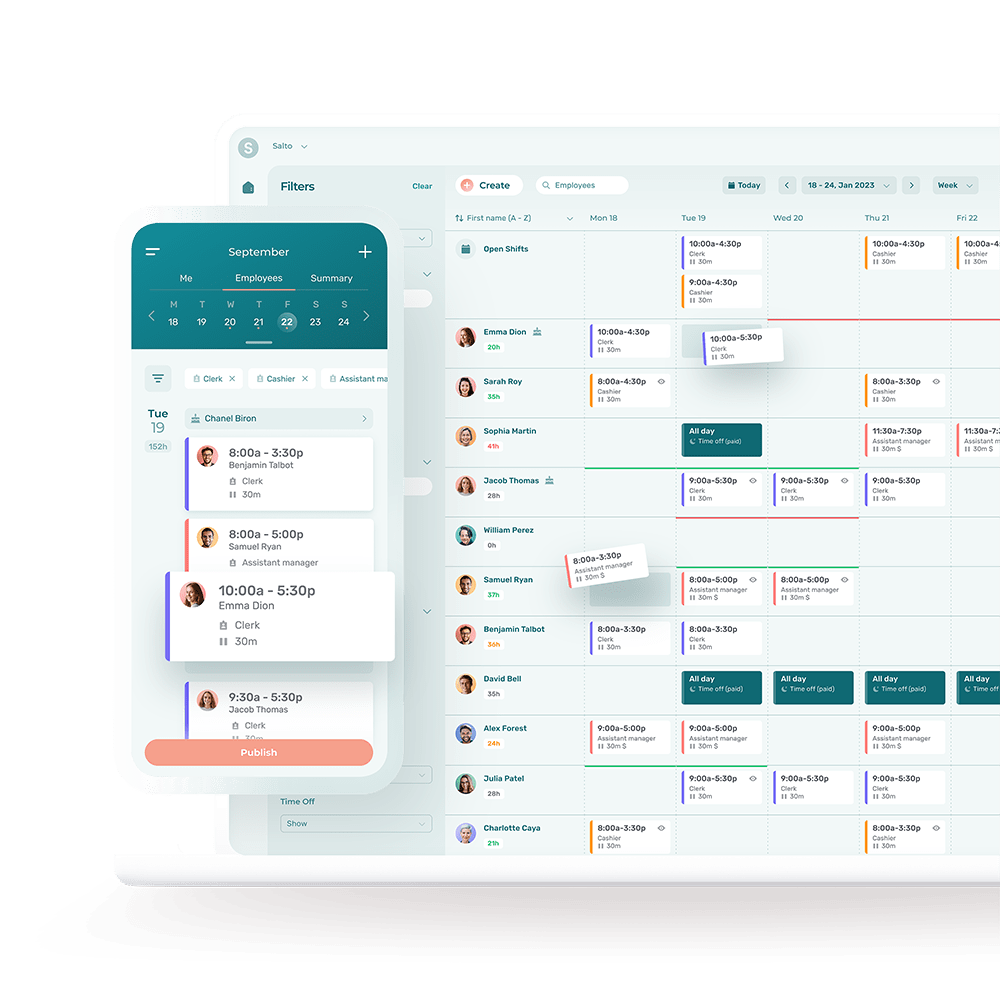Want to improve employee engagement in your organization? Remember that what gets measured, gets improved.
This guide tells you everything you need to know about creating and using employee engagement surveys to improve worker productivity and morale.
What Is an Employee Engagement Survey?
An employee engagement survey is a type of questionnaire used to measure employee morale. These surveys have become an essential component of a good listening strategy and enable business leaders to track trends in employee engagement and drive improvement. Employee engagement surveys can take the form of an annual employee satisfaction survey or an employee pulse survey distributed several times throughout the year.
What Is the Purpose of Surveys for Employee Engagement?
Employee engagement surveys serve four vital purposes:
- They give employees an opportunity to share feedback anonymously. The anonymous nature of employee engagement surveys creates a channel for honest communication. As a result even frustrated or uninspired employees can express their genuine opinions when answering employee engagement survey questions without fear of reprisal.
- They are a more reliable tool for measuring employee engagement. Most employees want to demonstrate that they can be team players. During one-on-one meetings with supervisors, this can prompt some employees to provide positively-skewed feedback. In contrast, team members are much more likely to answer employee engagement survey questions truthfully because they know they are anonymous.
- They can directly impact business success. When done thoughtfully and consistently, employee pulse surveys containing just a few questions can offer actionable insights on key drivers of engagement, such as recognition, working conditions and corporate culture.
- They can help improve the company culture and the employee experience. By regularly checking in to see how employees feel about their job, team and workplace, senior management can focus on employee engagement survey questions that target the creation of a more positive work culture in line with the company mission.
Looking for ways to improve employee retention and build more highly engaged teams? See: Best ways to engage employees
Employee Engagement Surveys vs. Face-To-Face Meetings
It can be difficult and time-consuming for leaders to hold intimate face-to-face discussions with each and every team member, especially on a regular basis. This is even more challenging with today’s hybrid and remote work setups.
A one-on-one meeting can be very productive in some situations, such as when a lot of specific follow-up questions need to be asked.
See: One-on-one Meetings: 20 Quick Tips for Success
When it comes to more delicate matters—corporate culture, management effectiveness, diversity and engagement, for example—team members may feel pressure to answer questions more favorably when they’re sitting across the desk from their immediate supervisor.
They may worry their answers will negatively impact their annual performance review.
In such cases, an anonymous employee survey will be more likely to result in more honest and accurate results.
9 Ways an Engagement Survey Can Support Business Leaders
- An employee survey gives every employee a voice.
- Employee surveys capture vital feedback for driving positive change.
- Asking the right employee survey questions allows you to identify areas where the company is doing well.
- Asking the right employee survey questions also helps you pinpoint areas needing improvement.
- An employee survey helps you connect the dots between employee engagement and the organization’s bottom line.
- It lets you compare and contrast engagement survey results among different employee groups.
- It provides clear insights on how to empower meaningful action and smarter decisions.
- It helps build employee trust because employees feel you care enough to take the time to regularly measure employee engagement.
- Maintaining a regular employee engagement index cultivates a stronger company culture.
Using employee engagement survey software from a trusted survey vendor can make it easier to collect employee feedback and develop survey questions that elicit constructive and actionable feedback.
Why Is an Employee Engagement Survey Important?
Extensive research shows that highly engaged employees can increase an organization’s productivity and bottom-line performance while reducing costs.
Engaged employees are more likely to work hard, set a positive tone with coworkers, and be an ambassador for the company’s brand and organizational values. They are also healthier and happier, which means lower rates of employee turnover, absenteeism and presenteeism.
Research also shows that dissatisfied or disengaged employees negatively impact these same key metrics, costing the U.S. over $450 to $550 billion per year in lost productivity.
Still other research suggests that only 19 percent of employees consider themselves “very engaged.”
Taken together, these findings make it clear that it is in every organization’s best interest to take a genuine interest in creating a highly engaged workforce. It also shows to what extent fostering a positive work environment can influence business performance.
Another key takeaway for human resources professionals is that organizations can’t simply send out employee engagement pulse surveys from time to time and think their work is done.
The management team must commit to thoroughly analyze the results and use this feedback to drive concrete change.
New to Evaluating Employee Engagement?
An employee satisfaction survey template can be a convenient way to get input from your team about the employee experience. Download the employee satisfaction survey template
30 Most Important Employee Engagement Survey Questions
A comprehensive employee engagement survey should include various forms of survey questions (multiple-choice questions, rating scale, open ended questions). These questions should touch upon various aspects of employee satisfaction.
Below are 30 survey questions all organizations should ask employees in their next engagement survey.
Satisfaction Questions
- Overall, how happy are you with your day-to-day work?
- Are you proud to be an employee at our company?
- Are you satisfied with your compensation and benefits?
- Do you enjoy working with your team?
- Does your job give you enough flexibility to pursue personal growth?
- Would you recommend our organization to others as a good place to work?
Career Development Questions
- Do you find your job interesting and challenging?
- Does your job align with your career goals?
- Do you see opportunities for career advancement within our organization?
- Are you given opportunities to learn new skills?
Support and Recognition Needs Questions
- Do you feel accepted by your team?
- Do you feel supported by your team?
- Do you feel you are fairly rewarded for your work?
See: Top employee recognition and appreciation ideas
Management and Leadership Effectiveness Questions
- Does your manager give you regular feedback on your job performance?
- Does your manager actively support your career aspirations?
- Is your immediate supervisor available when needed?
- Does your immediate supervisor take your suggested ideas and improvements to work methods seriously?
- Does your immediate supervisor act on your suggested ideas and improvements?
- Does your immediate supervisor inform you of decisions made regarding your suggested ideas and improvements?
Communication and Collaboration Questions
- Is there open communication across all levels of the organization?
- Are your job goals, tasks and responsibilities clear to you?
- Do you have access to the information you need to do your job well?
- Do you have access to the tools and equipment you need to remain productive at all times?
- Do you understand how your work affects the work of other employees and departments?
- Do you understand how the work of other employees and departments affects your work?
- Are changes within the organization communicated in a timely manner?
- Do you know what the company’s goals are for the next year? The next five years?
Empowerment Questions
- Do you feel empowered to make decisions affecting your work?
- Do you feel empowered to make suggestions to improve your work conditions?
- Do you feel empowered to address issues or concerns without fear of reprisal?
See: 56 questions to collect feedback from employees
What Are the Best Practices for Conducting Employee Engagement Surveys?
1. Frequency: How often should you conduct an employee engagement survey?
Many companies conduct annual surveys to measure employee engagement. This is often done around the same time as their employee performance reviews.
Distributing annual surveys can be a poor way to obtain an accurate real-time measure of employee engagement however. In fact, it can seriously skew your employee engagement results:
Throughout the year, there may be:
- Staff changes, such as employees who are hired, transferred, promoted, dismissed
- Changes in the organizational structure, chain of command, or corporate culture
- New tools and work methods introduced
- New programs regarding employee benefits, training and wellness
- New initiatives for improving equality or diversity
- Major product launch or innovation
- Loss of a major client or supplier
- Merger or acquisition
These and countless other factors can significantly impact job satisfaction and employee engagement.
By conducting employee engagement surveys on a more frequent basis, you can:
- Measure how specific changes are impacting how employees feel in real-time rather than months after the fact.
- Identify emerging issues before they escalate into more serious problems.
- Track trends in sentiment as employees adjust to changes.
- Communicate results and decision-making as it happens, rather than only at year-end.
- Let employees know that the organization takes their happiness seriously.
How to get real-time insights from employee engagement surveys without creating survey fatigue
There is no one-size-fits-all “ideal” frequency of employee pulse surveys. It will depend on:
- The current situation: is the organization going through a major change or upheaval?
- The specific issue being addressed in the survey: has a key driver of employee engagement been identified as seriously underperforming?
- The available resources: do you have the bandwidth to create, distribute, collect, analyze, actionize and communicate the results of multiple employee engagement surveys?
See more on frequency and types of survey questions to ask in this article on employee pulse surveys.
2. Length: How long should an employee engagement survey be?
An employee survey should not exceed 75 questions or take longer than 20 to 30 minutes to complete. If the survey is too long, response rates will be very low. This will lead to inaccurate survey results—and quite possibly, poor decision-making.
3. Response rate: How to increase employee engagement survey participation
Like any other organizational initiative, engagement surveys take time, energy, and resources. It’s only natural to want your survey response rate to be high.
At the same time, you also need to be realistic. Answering survey questions is the last thing your employees want to do when they have a heavy workload on their plate.
Below are a few tips for increasing the response rates to your employee engagement surveys:
- Explain the purpose of the employee engagement survey and how the results will be used to make the organization better.
- Link the survey to the importance of regularly measuring employee engagement and to the management team’s commitment to increase employee satisfaction.
- Limit the number of employee engagement survey questions.
- Limit the frequency of employee engagement surveys.
- Ask simple and clear questions; they should be pretty self-explanatory.
- Use different types of questions (multiple choice, rating scale and open-ended).
- Use terminology that’s easy for all team members to understand.
- Avoid distributing surveys too often to avoid survey fatigue and low response rates.
- Only measure drivers of employee engagement that you can take action on.
- Communicate to employees in a timely manner the results and decisions made in response to feedback from surveys.
- Invite employees to suggest ways to improve engagement surveys.
Good response rates for an employee engagement survey
- 70-80% for larger organizations of 500+ employees
- 80-90% for smaller organizations
How to Measure Employee Engagement
1. Analyze High-Level Results
Measure the survey response rate. If it’s below average or has fallen since your last employee engagement survey, review the list of best practices for increasing response rates and see where you can do better.
2. Evaluate “Favorable” Responses
“Favorable” refers to all positive answers to survey questions such as “Excellent”, “Strongly agree”, and “Agree”. Combined, these answers provide an overall view of employee engagement.
A favorability rate of 70% or higher is considered healthy.
3. Compare Results to Your Most Recent Survey
Having a snapshot of current employee engagement is helpful. Even more helpful is knowing if employee engagement levels are stable, on the rise, or falling drastically—and in what specific areas.
By comparing survey results over time, you can see a general trend is at play, or if a recent organizational change or initiative is impacting engagement levels.
4. Compare Results to Other Organizations
Different industries will have different key drivers of employee engagement:
- Working conditions might be especially important to team members in the construction or seasonal and tourism industries.
- Work-life balance might be key to employees in the homecare or hotels & hospitality industries.
- Compensation and opportunities for career advancement can be a huge talent magnet in the offices & call centers industries.
- Flexibility/control over working hours is must for many workers in the retail and restaurants & bars industries.
Comparing your employee engagement levels to similar organizations will tell you if your company has a competitive advantage or is falling short of what is considered “good” for your industry.
5. Examine Differences in Engagement Levels Across Various Teams and Departments
Dig deeper into your survey results to see how engagement levels compare throughout the organization. There’s a good chance that different teams will have different concerns.
As a result, some of your employee engagement action plans may be organization-wide and rolled out on a longer term basis, while others might need to be implemented immediately and in a highly targeted manner.
6. Gather More Context
Carefully analyze the responses to open-ended survey questions to fully understand employee engagement trends in numeric data.
Take this example of why context is important when analyzing answers to employee engagement survey questions:
The results of your most recent employee engagement surveys show that almost all front-line staff at one of your retail stores answered “Strongly disagree” or “Somewhat disagree” to the question: “Are you happy with your current work hours?”
Including a follow-up open-ended survey question such as: “Why or why not” might elicit additional information to help you understand these unfavorable answers.
It might be that three senior staff members recently quit and that the remaining team is working overtime until new employees can be hired and fully onboarded.
This might be a temporary issue that’s easily corrected. Or it could be the sign of a more serious problem, such as ineffective leadership or poor employee management.
7. Take Concrete Action
If your engagement surveys reveal areas that could be jeopardizing employee engagement, create an action plan. An engagement action plan outlines the steps you need to take to address employee engagement problem areas identified through your various forms of employee feedback.
8. Validate Impacts by Measuring Employee Engagement Regularly
Improving company culture in a meaningful and lasting way takes sustained effort and the full buy-in of the entire management team. But not all initiatives will bring the desired results.
Tracking employee engagement trends in the weeks and months that follow the implementation of a new engagement initiative will tell you if efforts are on the right track for creating a work environment that empowers an engaged workforce while also staying aligned to the organization’s vision.
Tools to Measure Employee Engagement
A growing number of management teams now rely on technology to improve all aspects of the employee experience.
A few examples of software used to improve employee engagement include:
- Employee engagement survey software: used to create, conduct and measure the employee engagement with minimal effort
- Employee scheduling software: used to give employees more control over their work schedules and to simplify scheduling tasks for managers
- Employee recognition software: used to make recognition a part of the company culture to improve this key driver of employee engagement
Want to Improve Business Performance? Ask Your Employees!
Conducting regular employee engagement surveys is a key component of any effective listening strategy—and a good first step in improving organizational success.
Organizational leaders who make the discretionary effort to define employee engagement, to find out what their employees think about the organization’s culture, and to use this feedback to introduce meaningful change will see improvements in employee engagement, productivity and retention.
Conclusion
All successful companies take a genuine interest in their employees. Those that invest time and resources into an employee engagement strategy consistently report gains virtually across the board.
With a regular employee engagement survey, you’ll be able to connect the dots between what employees expect and need to do their best work to support your organization’s long-term success.
Want to Become a More Effective Manager?
Leverage the top employee management tools to build a highly engaged workforce. See 15 HR tools every manager should know about











